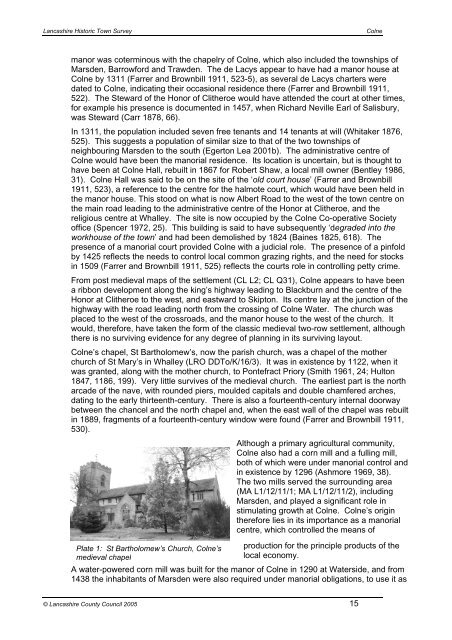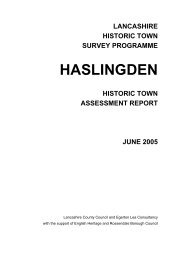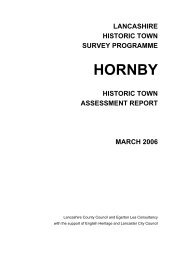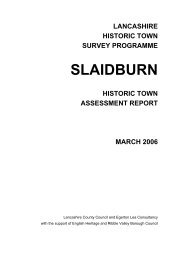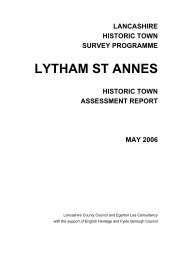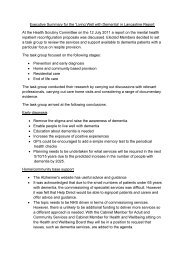Colne - Lancashire County Council
Colne - Lancashire County Council
Colne - Lancashire County Council
Create successful ePaper yourself
Turn your PDF publications into a flip-book with our unique Google optimized e-Paper software.
<strong>Lancashire</strong> Historic Town Survey<strong>Colne</strong>manor was coterminous with the chapelry of <strong>Colne</strong>, which also included the townships ofMarsden, Barrowford and Trawden. The de Lacys appear to have had a manor house at<strong>Colne</strong> by 1311 (Farrer and Brownbill 1911, 523-5), as several de Lacys charters weredated to <strong>Colne</strong>, indicating their occasional residence there (Farrer and Brownbill 1911,522). The Steward of the Honor of Clitheroe would have attended the court at other times,for example his presence is documented in 1457, when Richard Neville Earl of Salisbury,was Steward (Carr 1878, 66).In 1311, the population included seven free tenants and 14 tenants at will (Whitaker 1876,525). This suggests a population of similar size to that of the two townships ofneighbouring Marsden to the south (Egerton Lea 2001b). The administrative centre of<strong>Colne</strong> would have been the manorial residence. Its location is uncertain, but is thought tohave been at <strong>Colne</strong> Hall, rebuilt in 1867 for Robert Shaw, a local mill owner (Bentley 1986,31). <strong>Colne</strong> Hall was said to be on the site of the ‘old court house’ (Farrer and Brownbill1911, 523), a reference to the centre for the halmote court, which would have been held inthe manor house. This stood on what is now Albert Road to the west of the town centre onthe main road leading to the administrative centre of the Honor at Clitheroe, and thereligious centre at Whalley. The site is now occupied by the <strong>Colne</strong> Co-operative Societyoffice (Spencer 1972, 25). This building is said to have subsequently ‘degraded into theworkhouse of the town’ and had been demolished by 1824 (Baines 1825, 618). Thepresence of a manorial court provided <strong>Colne</strong> with a judicial role. The presence of a pinfoldby 1425 reflects the needs to control local common grazing rights, and the need for stocksin 1509 (Farrer and Brownbill 1911, 525) reflects the courts role in controlling petty crime.From post medieval maps of the settlement (CL L2; CL Q31), <strong>Colne</strong> appears to have beena ribbon development along the king’s highway leading to Blackburn and the centre of theHonor at Clitheroe to the west, and eastward to Skipton. Its centre lay at the junction of thehighway with the road leading north from the crossing of <strong>Colne</strong> Water. The church wasplaced to the west of the crossroads, and the manor house to the west of the church. Itwould, therefore, have taken the form of the classic medieval two-row settlement, althoughthere is no surviving evidence for any degree of planning in its surviving layout.<strong>Colne</strong>’s chapel, St Bartholomew’s, now the parish church, was a chapel of the motherchurch of St Mary’s in Whalley (LRO DDTo/K/16/3). It was in existence by 1122, when itwas granted, along with the mother church, to Pontefract Priory (Smith 1961, 24; Hulton1847, 1186, 199). Very little survives of the medieval church. The earliest part is the northarcade of the nave, with rounded piers, moulded capitals and double chamfered arches,dating to the early thirteenth-century. There is also a fourteenth-century internal doorwaybetween the chancel and the north chapel and, when the east wall of the chapel was rebuiltin 1889, fragments of a fourteenth-century window were found (Farrer and Brownbill 1911,530).Plate 1: St Bartholomew’s Church, <strong>Colne</strong>’smedieval chapelAlthough a primary agricultural community,<strong>Colne</strong> also had a corn mill and a fulling mill,both of which were under manorial control andin existence by 1296 (Ashmore 1969, 38).The two mills served the surrounding area(MA L1/12/11/1; MA L1/12/11/2), includingMarsden, and played a significant role instimulating growth at <strong>Colne</strong>. <strong>Colne</strong>’s origintherefore lies in its importance as a manorialcentre, which controlled the means ofproduction for the principle products of thelocal economy.A water-powered corn mill was built for the manor of <strong>Colne</strong> in 1290 at Waterside, and from1438 the inhabitants of Marsden were also required under manorial obligations, to use it as© <strong>Lancashire</strong> <strong>County</strong> <strong>Council</strong> 2005 15


